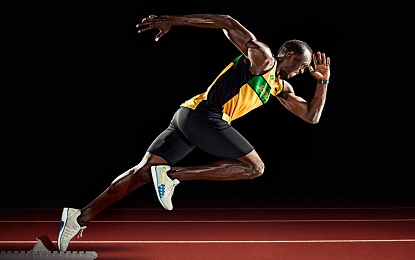Practical Application and Training for Speed
The technical definition of speed is a measure of one’s rate of motion. Speed may also be defined as the rate of change in position. It is measured or expressed as the distance moved per unit of time- miles per hour, kilometers per hour, feet per second, or meters per second. When we are looking at people, we are interested in how fast does an individual move.
In terms of activity, what does it mean to be fast, or to have speed? Certainly, we want to measure and state clearly, in terms of distance and time, how fast a person moves. Most often, we look at how long does it take for someone to get from point A to point B- one’s rate of linear motion or rate of change in linear position. It is also strictly in a horizontal direction. We should also consider:
- The rate of motion or positional change in the limbs or body segments- the hands, the feet, the arms, and the legs, such as in throwing or kicking motions. This is rotational motion.
- The rate of motion or change from one position to another, such as a football lineman coming up out of his three-point stance. This is also a rotational motion, combining several limbs and several body segments.
- The rate of motion or positional change in a vertical direction, such as leaping, jumping, or hopping.
These are just as important to human performance as the traditional view towards moving straight ahead. An individual’s 40 yard dash time is important, but it does not tell the whole story of a person’s capabilities. A fast 40 does not tell us about that person’s ability to avoid obstacles or other people, or how quickly they swing a bat or a golf club, or how quickly they jump. Also, more practically, what do we know about the non-athlete and their ability to move through the normal daily course of events? It is not only important to run fast but to move quickly in all aspects of our lives.
The examples cited above come from the realm of athletics but isn’t important for the average person to also have the ability to move with speed. If a child stumbles in front of you, you would want good hand speed to catch and steady them. Life moves not only linearly and horizontally, but vertically, rotationally, laterally, and sometimes, even in reverse. How can quickly can you step (or jump) back onto the sidewalk if a fast-moving car on the street bears down on you?
Speed is predicated on the rapid interaction between the nervous system and muscular system- a group of muscles and the nerve that activates it is called a motor unit. We develop a thought to move, and the nerve must transmit that thought rapidly, strongly, and repeatedly to the muscles to contract. The stronger and more frequent those signals, the stronger and more rapidly the muscle will contract.
The muscle’s ability to contract quickly depends on the energy system that it uses, the energy stored in it, and the type of fibers that compose the muscle, and its ability to recover and repeat the process. The muscle’s ability to perform can be measured and stated in terms of muscular strength, muscular endurance, and range of motion. Strength is the amount of force generated to match a weight or resistance when the muscle contracts. Endurance is the muscle’s ability to repeatedly contract. A range of motion, also called flexibility, describes how far the muscle can move the bones of the joint that it covers.
Click Here to Read:- Review of the 12 Things Which Increase Belly Fat Rapidly
How can we all, athlete and non-athlete, develop speed? We need to train those specific neuron-muscular characteristics described above- strength, endurance, and flexibility. The goal of training should be the stimulation and excitation of those motor units to work together efficiently, rapidly, and in the proper sequence. The energy systems associated with speed also need to be trained and developed- a tolerance for the build-up in heat and lactic acid as a result of energy metabolism needs to be in place. Therefore, training needs to be done at speeds closely tied to those of the activities that we perform- both as athletes and non-athletes.
Preferably, we should aim for activities that allow us to train all these aspects simultaneously. In traditional training methods, exercise sessions are dedicated specifically to strength, endurance, aerobic/anaerobic capacity, and speed.
Practical Application and Training for Speed



